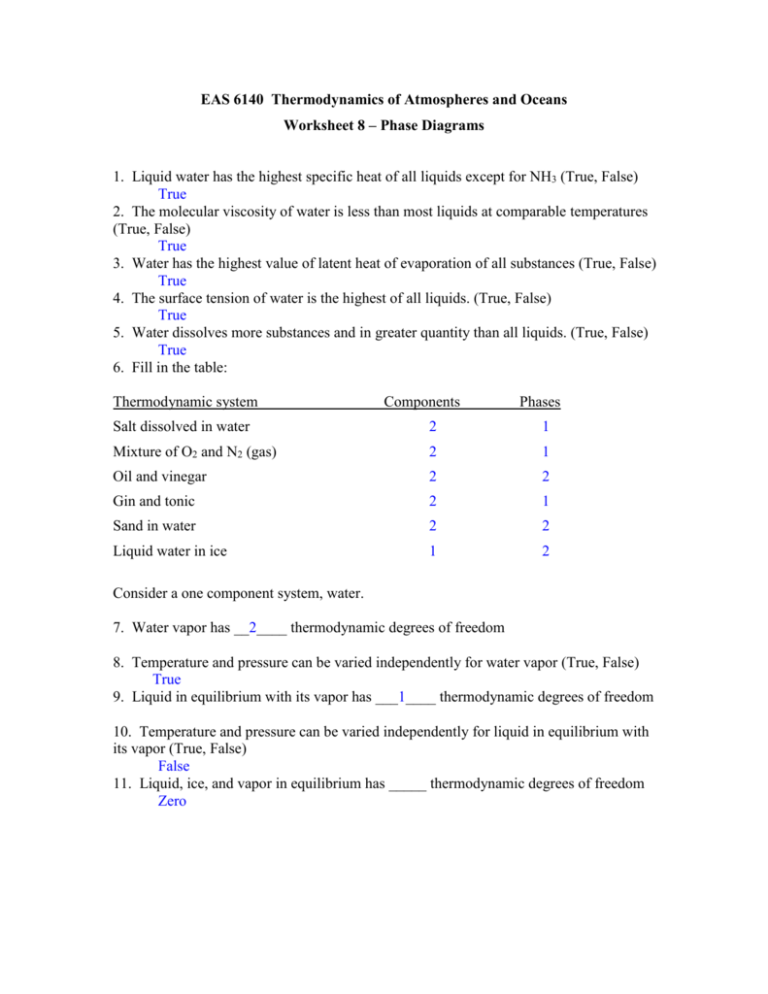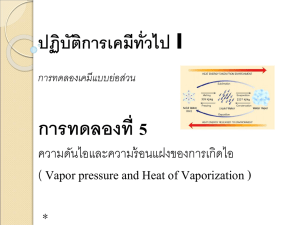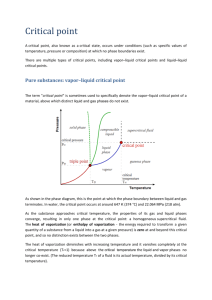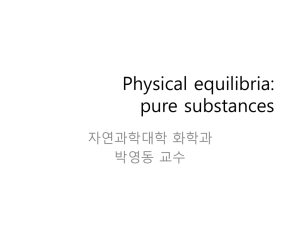Answers
advertisement

EAS 6140 Thermodynamics of Atmospheres and Oceans Worksheet 8 – Phase Diagrams 1. Liquid water has the highest specific heat of all liquids except for NH3 (True, False) True 2. The molecular viscosity of water is less than most liquids at comparable temperatures (True, False) True 3. Water has the highest value of latent heat of evaporation of all substances (True, False) True 4. The surface tension of water is the highest of all liquids. (True, False) True 5. Water dissolves more substances and in greater quantity than all liquids. (True, False) True 6. Fill in the table: Thermodynamic system Components Phases Salt dissolved in water 2 1 Mixture of O2 and N2 (gas) 2 1 Oil and vinegar 2 2 Gin and tonic 2 1 Sand in water 2 2 Liquid water in ice 1 2 Consider a one component system, water. 7. Water vapor has __2____ thermodynamic degrees of freedom 8. Temperature and pressure can be varied independently for water vapor (True, False) True 9. Liquid in equilibrium with its vapor has ___1____ thermodynamic degrees of freedom 10. Temperature and pressure can be varied independently for liquid in equilibrium with its vapor (True, False) False 11. Liquid, ice, and vapor in equilibrium has _____ thermodynamic degrees of freedom Zero 7. On the diagram below is the phase diagram for water in the p-T plane. Label the following on the diagram: a) triple point b) critical point c) fusion curve Mark on the diagram points which are examples of each of the following A. A parcel of unsaturated vapor B. A parcel containing liquid and solid in equilibrium C. A parcel of saturated vapor and liquid in metastable equilibrium at temperaturre below 0oC. Fusion Curve Pcrit Liquid Solid B A Ptr 6.11hPa C Vapor 273.16K 8. At temperatures below the triple point, the saturation vapor pressure over liquid water is (greater than, less than, equal to) the saturation vapor pressure over ice. Greater than 9.. Water existing below the freezing point is called __super cooled_______ 10. The change of phase from gas to solid is called ___deposition________ 11. Refer to Fig. 4.4. During a phase change from liquid to vapor, state whether the following variables increase, decrease, or remain the same Temperature __same________________ Pressure __same________________ Specific Volume __increase_____________ 12. During a phase change from liquid to vapor, state whether the following variables increase, decrease, or remain the same Entropy __increase_____________ Enthalpy __increase_____________ Gibbs energy __same________________ Phase equilibria 1. Chemical potential is defined as __ Gibbs Free Energy_____ per mole 2. The difference in enthalpy between the liquid and solid phases is called ___latent heat of fusion____ 3. Matching: ____C____________ latent heat of fusion a. 677 cal g-1 ____B____________ latent heat of vaporization b. 597.3 cal g-1 ____A____________ latent heat of sublimation c. 77.7 cal g-1 4. When water freezes (liquid- solid phase transition), does the entropy increase or decrease? decrease 5. When water boils (liquid- vapor phase transition), does the entropy increase or decrease? increase 6. How many thermodynamic degrees of freedom are associated with equilibrium between vapor and liquid phases? 1 Derive an equation for the slopes of the equilibrium line between liquid and vapor in the phase diagram in #3. Follow the steps below. 12. Write the first and second law combined, Gibbs energy form, intensive, for a reversible process. dg dT vdp 13. Write #12 for the vapor phase (indicated by subscript 1 on the variables) and for the liquid phase (indicated by subscript 2 on the variables) (4.12) dg1 1dT v1dp dg 2 2 dT v2 dp 14. In the context of #12, what are the conditions for equilibrium between phases (say liquid and vapor?) When dg is the same for each phase dg1 dg2 15. Using the results from #13 and #14, write a single equation that reflects the equilibrium between the liquid and vapor phases. If you have done this correctly, you should have obtained equation (4.13) If dg1 dg 2 then 1dT v1dp 2 dT v2 dp 16. The slope of the equilibrium line between liquid and vapor is dp/dT. Using the results from #15, write an expression for the slope of this line. (4.14) dp 1 2 h L dT v1 v2 v T v T v 17. The enthalpy change during the transition between the vapor and liquid phases is called latent heat of vaporization, where h = hl - hv =Llv. Use the first and second law combined, enthalpy form, to evaluate the change in entropy during this phase transition. (4.11) dh Td vdp vdp 0 h L Td L L d T 18. Combine the results from #16 and #17 to write equation for dp/dT, that does not include entropy (4.17) Llv dp dT T (vv vl ) 19. At the triple point (T=273.16K, p=6.11 hPa, is the specific volume of water vapor (greater than, less than) the specific volume of liquid water. (Note this difference in specific volume values is several orders of magnitude). Greater than vv 206m3 / kg vl 103 m3 / kg vv vl 20. Rewrite the expression in #18, neglecting the smaller specific volume (4.18) dp Llv dT Tvv 21. Substitute the ideal gas law for vv into the expression in #20. This is the ClausiusClapeyron equation, and gives an expression for the variation of the saturation vapor pressure with temperature. (4.19) RT pv RT v p dp Llv p dT RvT 2 22. Integrate the expression in #21 assuming that Llv(T) is constant over the range T1, T2. e = water vapor pressure e2 T2 L p d (ln e ) e1 T1 RvlvT 2 dT ln L 1 1 e2 lv e1 Rv T2 T1 L 1 1 e2 e1 exp lv Rv T2 T1 23. Examine Table 4.2. Is the assumption Llv(T) is constant a good one? Under which conditions would this not be a good assumption? Generally speaking it is a reasonable assumption as long as the change in T is small. It does however become problematic with large changes in T, near the triple point, and in places where we switch signs.








